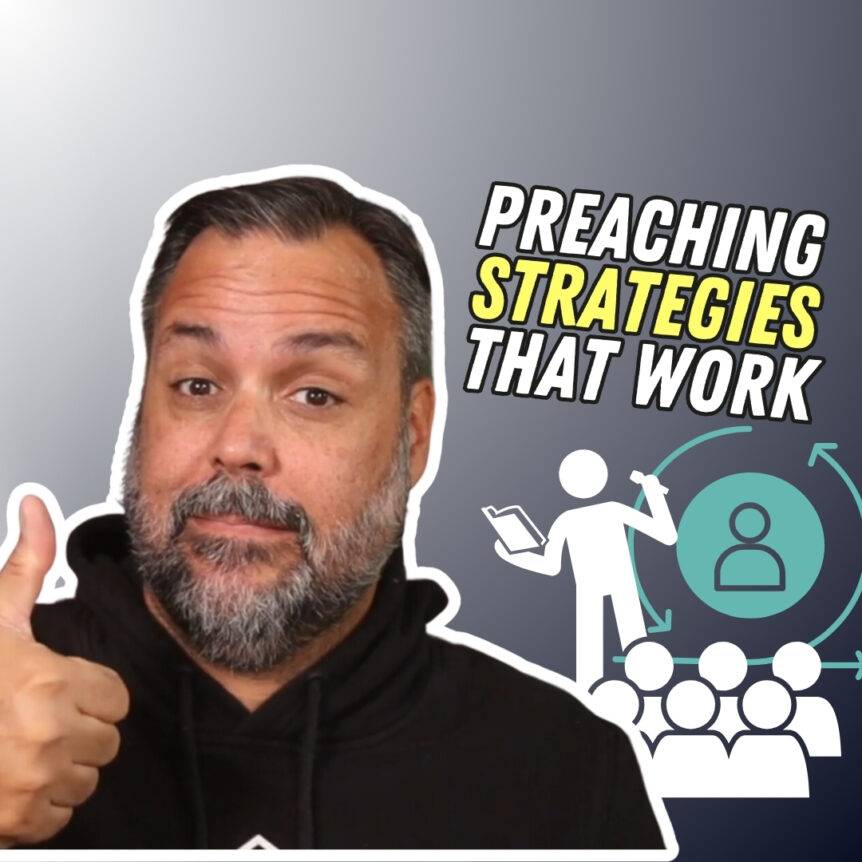How many sermons have you preached? Ten? Fifty? A hundred?
If you’ve been preaching long enough, you know that there are tons of different ways to preach. You can do a one-off sermon or a sermon series. You can use a slideshow or not use screens at all. But out of all of these, which ones are the best?
In this episode, we rank the top 13 sermon strategies on a couple different criteria. We encourage you to use this list as a way to help you choose your strategy for your next sermon!
Estimated reading time: 9 minutes
Table of contents
Ranking Sermon Strategies

Before we get into our list of the top 13 sermon strategy ideas, we should clarify exactly what we are basing all of these rankings on. Of course, all of these rankings are completely subjective; anything you preach out of God’s word with a pure heart can make an impact.
Even so, it’s good to know what we are looking at when discussing what makes a great preaching strategy, and what makes a bad preaching strategy. We’ll also include the 3-part scale we are using to rank each strategy.
Evaluating Sermon Strategies
Evaluating different sermon strategies starts with understanding your audience. Think about their needs, preferences, and spiritual maturity. Are they new believers, long-time Christians, or a mix?
Next, consider your message. Is it best shared through storytelling, teaching, or a mix? Match the strategy to the message. For example, a series works well for deep topics, while a one-off sermon fits special events.
Test how each strategy feels to you. Are you comfortable using visuals like slides or trying an object lesson? Consider time and resources, too. Can you prepare a drama or interactive segment in advance?
Gather feedback after trying a strategy. Ask your audience what they learned or enjoyed. Reflect on the sermon’s impact—did it inspire action or understanding? Adjust based on what works best for your congregation. With practice, you’ll find a balance that connects deeply with your audience.
Ranking System
Our ranking system helps us to rank sermon strategies based on their role in guiding believers. Strategies re grouped into three categories:
- Guiding Light: These strategies shine brightly, leading people closer to Christ Jesus with clarity and impact.
- Green Pasture: These sermon strategies are solid, but may not be stand-out
- Still Water: These strategies are stagnant, and we wouldn’t recommend them.
Top 13 Sermon Strategies

Now it’s time to get into our list of the top 13 sermon strategies. These strategies will be evaluated and put into one of the three ranking categories listed in the section above.
Let’s get into it.
1. Sermon Series vs. One-off
A sermon series dives deeply into a theme or book over weeks, giving more time to explore complex ideas. One-off sermons focus on a single message for a specific moment, like holidays or unique events. Series build continuity, helping people connect messages, while one-offs offer flexibility for special needs. Both work well, depending on the goal and timing. Choose based on your audience and the story you want to tell.
2. Playing Movie Clips
Movie clips can bring sermons to life by connecting biblical truths to familiar stories. They grab attention, stir emotions, and help explain complex ideas in relatable ways. Choose clips wisely—keep them short, relevant, and appropriate for all ages. After showing the clip, tie its message to Scripture clearly. Be mindful of copyright rules and ensure the content supports your main point, not distracts from it.
3. Using a Slideshow
Slideshow presentations can highlight key sermon points, Bible verses, or images that clarify your message. They help visual learners and keep people engaged. Make slides simple and easy to read, avoiding too much text or distracting designs. Use visuals sparingly to enhance, not overshadow, the sermon. Practice syncing slides with your speech for smooth delivery, and test equipment beforehand to avoid technical problems.
4. Prepping a Message Alone vs. with a Group
Preparing alone allows for deep focus, prayer, and personal reflection, while group preparation offers fresh perspectives and creative ideas. Collaboration can reveal blind spots or strengthen weak areas. Choose based on your style and message needs. Alone suits personal storytelling, while groups help with brainstorming themes or illustrations. Whichever approach, seek God’s guidance, and make sure your message stays clear and authentic.
5. Seasonal Messages

Seasonal messages tie sermons to holidays or events like Easter, Christmas, or Thanksgiving. They connect Scripture to the season’s meaning, helping people reflect on their faith. Seasonal themes often draw more attendees, so use them to encourage deeper connections. Plan ahead, choosing topics that resonate with the season but also remain timeless. Keep the message fresh, even if covering familiar themes like the nativity or resurrection.
6. Using Items to Illustrate Points
Object lessons use physical items to make abstract ideas easier to understand. For example, a mustard seed illustrates faith’s potential, while a mirror reflects self-examination. These visuals capture attention and help people remember key points. Choose items that are simple, relatable, and tied to your message. Avoid over-complicating the demonstration, so it complements rather than overshadows your sermon’s core message.
7. Interactive Q&A
Interactive Q&A lets your congregation engage with the sermon in real time. It fosters dialogue, clears doubts, and makes the message more relevant. Encourage honest questions and be prepared to respond thoughtfully. Use this strategy in smaller settings or special sessions to maintain focus. Limit time for Q&A to avoid going off track and keep answers concise. It’s a great way to connect and deepen understanding.
8. Sharing a Personal Story
Sharing personal stories adds authenticity and emotional depth to your sermon. People connect better when they see how Scripture has impacted your life. Keep the story relevant to your message and avoid making it overly long or self-centered. A well-told story can inspire, teach, and encourage listeners to apply biblical truths in their own lives. Pray for wisdom to choose stories that glorify God and serve others.
9. Using Modern Analogies/Parables
Modern analogies or parables make biblical truths relatable by connecting them to everyday life. For example, comparing God’s guidance to GPS navigation helps clarify abstract ideas. Choose analogies that fit your audience’s experiences and avoid overly complicated comparisons. These stories help listeners see how Scripture applies to their own lives, making the message more practical and memorable. Always tie the analogy back to the Bible clearly.
10. Speaking on Current Events

Linking sermons to current events shows how Scripture addresses real-world issues. It helps people see the Bible’s relevance in today’s challenges. Be sensitive to your audience’s emotions and avoid political bias unless it directly supports biblical teaching. Focus on hope, wisdom, and God’s sovereignty amidst uncertainty. Keep the connection short and always bring the focus back to Scripture’s eternal truths.
11. Expository Preaching
Expository preaching explains Scripture verse by verse, uncovering its meaning and context. This method deepens understanding and strengthens biblical knowledge. It’s ideal for teaching difficult passages or themes. Avoid overwhelming your audience with too much detail—balance explanation with application. Use clear language to unpack complex ideas, showing how they apply to daily life. This approach nurtures spiritual growth and builds a foundation of Scripture knowledge.
12. Practicing in Front of a Church Board First
Practicing in front of a trusted group, like a church board, gives valuable feedback before delivering the sermon. They can point out unclear points, distractions, or areas to improve. It helps refine delivery and builds confidence. Choose people who will offer constructive criticism and encouragement. Be open to suggestions, but stay true to the core message God has given you. This process ensures a more impactful sermon.
13. Partner Preaching (e.g., Father-Wife Duos)
Partner preaching pairs two voices to present a message together, offering fresh dynamics and perspectives. For example, a father-daughter duo might share different generational insights. This approach engages diverse listeners and highlights the unity of shared faith. Plan transitions and speaking roles carefully to keep the flow natural. It works well for themes like relationships or teamwork. Balance voices equally, ensuring both partners contribute meaningfully.
Exploring Sermon Strategies

Choosing the right sermon strategies is a thoughtful process that considers your audience, message, and available resources. Whether delivering a single, impactful one-off sermon or diving deeply into a multi-week series, each approach brings unique benefits.
Using tools like slideshows, movie clips, or object lessons can enhance engagement, while techniques like storytelling or modern analogies make biblical truths relatable. Interactive elements like Q&A sessions or collaborative preparation can create deeper connections with your congregation.
Testing strategies, seeking feedback, and remaining prayerful ensure your approach resonates effectively. Remember, no single method works for every situation—flexibility and intentionality are key. Each sermon is an opportunity to inspire, teach, and lead others closer to God. By balancing creativity with clarity and relying on the Holy Spirit, you can communicate God’s Word in a way that transforms lives and strengthens faith within your community.
Ultimately, each sermon should draw people closer to God and inspire them to live out their faith with purpose. Let us know what sermon strategies you like in the comments below!
More Resources on Sermons





